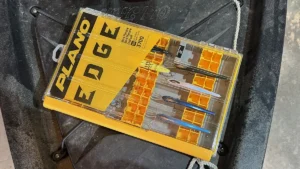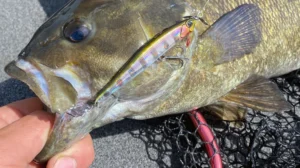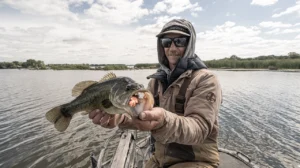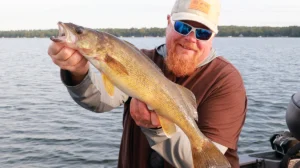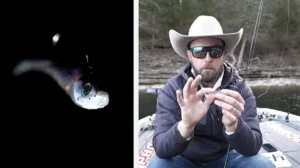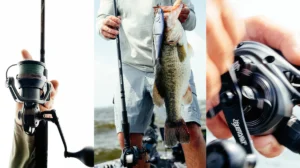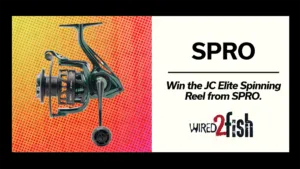I listened to a recent episode of the Cut & Retie podcast in which host Joe Ceremele and guest Chris Bohlman from the “Retro Bassin’” YouTube channel got me thinking about my own vintage tackle choices. I’m old enough now that the stuff I grew up throwing has found its way to the shelves of collectors. But instead of gathering dust, my old-school lures are still in the rotation—and still catching fish. The good news? Many of these vintage patterns can still be found on store shelves. Here’s some of my favorite blasts from the past.

ARBOGAST HULA POPPER
Fed Arbogast is the brains behind many things we take for granted, including skirted jigs and bladed baits such as the spinner- and buzzbait. One of the first lures he put that skirt on was the Hawaiian Wiggler, an in-line spinner that was the precursor to the buzz baits of today. In 1941, Arbogast introduced the Hula Popper, a floating popper with a concave mouth that creates a surface-shattering pop and a bubble trail when retrieved. It’s existed in much the same form ever since, with the trademark rubber skirt. I’ve always found this lure to be most productive when worked so slowly it’s painful, only popping it again after all the ripples from the last tug have dissipated. I’ve caught some really large bass as it just sits there, disappearing in the hole only a big bucketmouth can create. Nowadays, you can get the Hula Popper in 1 3/4, 2, and 2 1/4 inch sizes, weighing 1/4, 3/8 and 5/8 ounces respectively.
SMITHWICK DEVIL’S HORSE
It’s hard to pin down the exact origin of the Smithwick Devil’s Horse, but it probably first hit a bass pond at the end of Jack Smithwick Sr.’s line somewhere in the neighborhood of 1960. The lure had a few names throughout its history, including the “Devels Warhorse,” but most accounts have it as the Devil’s Horse when mass production started. A rose by another name, this topwater prop bait catches fish as well today as it did 60 or so years ago. Double props mean lots of noise, and you can hear it from a mile away. The floating properties mean you can work this as slowly as you want. I take advantage of that, retrieving it with short but powerful strips, with long pauses between. The hit will usually come as it’s sitting there, so hold on. For whatever reason, pike and pickerel seem to love these, so bring a few extras for when their teeth sever your line. I’m fond of the yellow and black stripes, but silver is another top performer. These measure 4 1/2 inches and come in 3/8 and 1/2 ounce weights.
ZARA SPOOK
You’d be hard pressed to find a fisherman that hasn’t heard of the Zara Spook. This is the original walk-the-dog bait, introduced as the Zaragossa 6500 sometime before 1939. The Zaragossa was wood, but advances in molding processes allowed Heddon to release the Spook in a plastic version in 1939. Since then, it has caught just about everything that swims in freshwater and salt. The ability to work with a variety of retrieves makes the Spook so versatile. Because it floats, you can work it at snail’s pace, or reel it in quickly to create more surface disturbance. Start out slow and let the fish tell you what they want. There’s plenty of colors that work, but for my money it’s hard to beat bone, red/white, and black shiner. You can get the Spook in a wide variety of sizes so you can match the forage in your lake, or go with the biggest and shoot for the moon.
HEDDON TORPEDO
Heddon was founded by James Heddon in 1902, selling lures he made by hand in the kitchen of his home in Dowagiac, Michigan. By 1950, the lure maker went from a cottage industry to a household name. My research didn’t provide an exact date that the Torpedo was produced, but there’s indications that some version of the plug was around as early as 1925. The floating bait has a prop on the rear, which gives it a nose-up attitude that helps push water and keep the propeller engaged for plenty of noise. I caught my first 5-plus pounder on a Torpedo when I was kid, fished slowly after dark. The strike just about ripped the pole out of my hands, and I’ve been a fan of the bait ever since. This one works just as well during the day though, particularly on schooling fish. Black shore minnow is my favorite after dark, and baby bass, natural finish perch, and G-finish shad are go-tos when the sun is up.
ARBOGAST JITTERBUG
The Jitterbug is another Arbogast classic, first hitting the market in 1939. The signature characteristic of the Jitterbug is the wide metal lip, which gives it a distinctive gurgling sound and side-to-side wiggle. The action is too much to resist, and I’ve had bass not much bigger than the plug nearly come out of the water to get it. It’s not just a tiny fish bait though, and it’ll pull 3-plus pounders all day—and night. I have always liked black for fishing after dark, but have had the most luck with the perch color when the sun is up, though your results may vary. During the day, I like to work it in an irregular cadence, taking nervous pauses to tempt cautious bass into striking. But at night, I drag this in using a constant medium pace. You can find this classic in 2, 2 1/2, and 3 inch sizes, weighing 1/4, 3/8, and 1/2 ounces.
OLD PLUGS, NEW TRICKS
There’s a tendency to embrace the latest and greatest, but that doesn’t mean the plugs of yesterday don’t still catch plenty of fish. In fact, many of them might be even more productive as they have fallen out of favor, and the fish just don’t see them as often. So do you like your grandpa did, and throw a few of these in your tackle box. It’s nice to fish with a piece of history that you won’t be too upset about if it ends up in a tree or bitten off by a pike.







